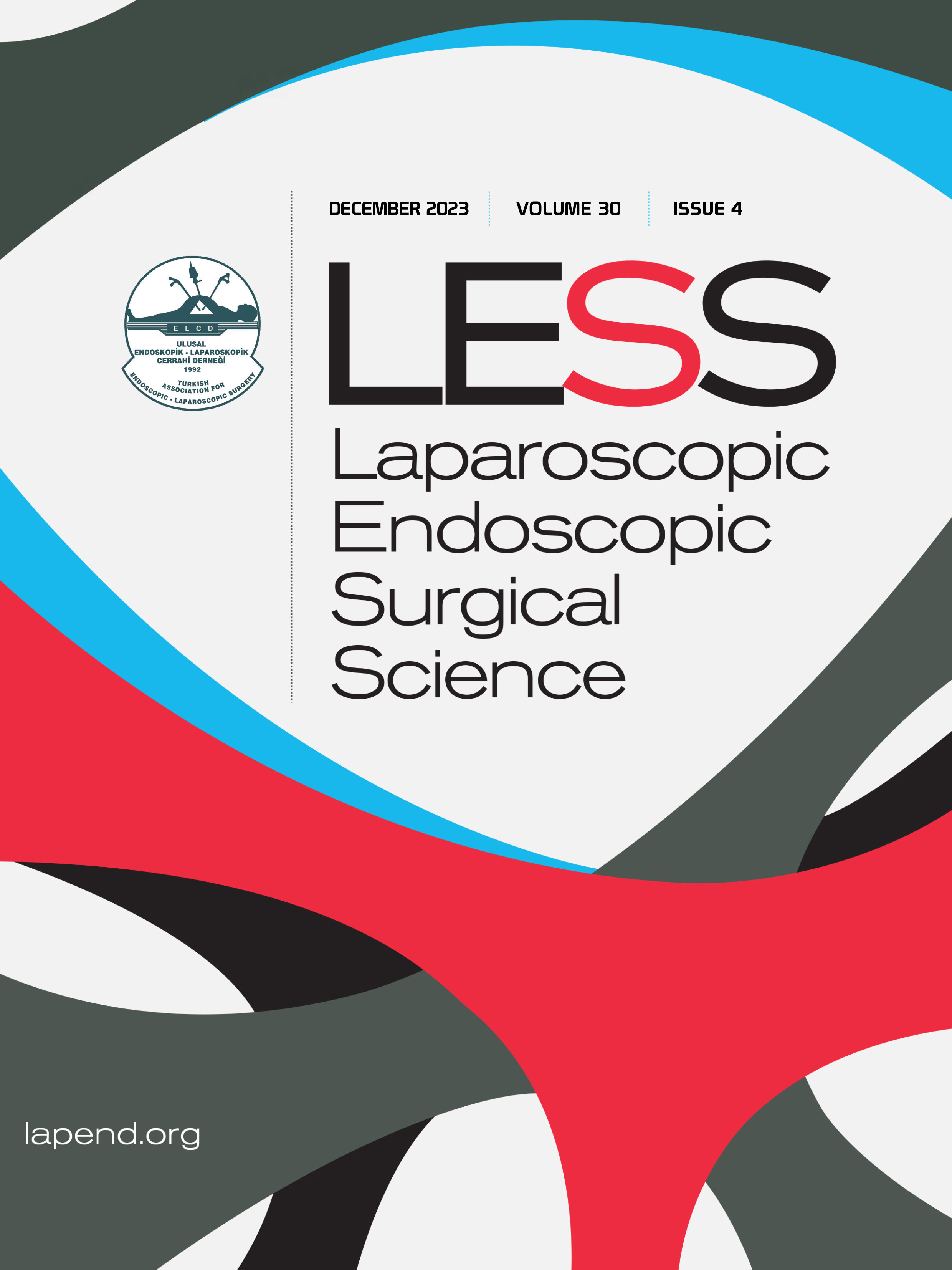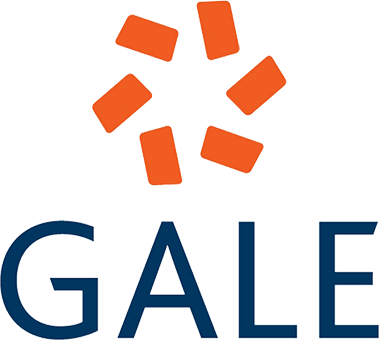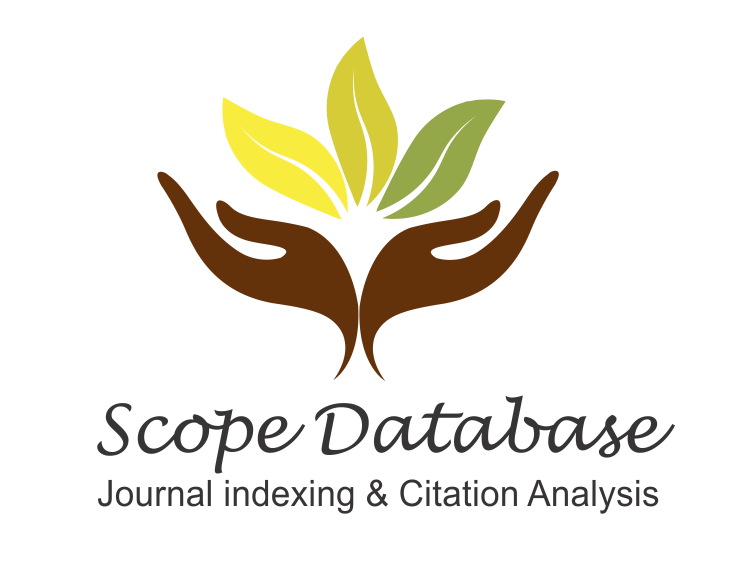Volume: 30 Issue: 3 - 2023
| OTHERS | |
| 1. | Front Matter Pages I - V |
| RESEARCH ARTICLE | |
| 2. | Incidence and risk factors of gallstone formation after bariatric surgery Gülten Çiçek Okuyan, Aytaç Selman doi: 10.14744/less.2023.67984 Pages 81 - 89 INTRODUCTION: The primary aim of this research was to investigate the incidence and potential risk factors associated with gallstone formation following bariatric surgery. METHODS: A retrospective analysis was conducted on 478 patients who underwent bariatric and metabolic procedures between January 2017 and June 2021. After applying specific inclusion and exclusion criteria, 254 patients were deemed suitable for the study. Data, including age, gender, pre-operative body weight, body mass index (BMI), weight loss, familial history of gallstones, and duration of follow-up, were meticulously recorded and analyzed. RESULTS: Out of the 254 patients, 31.1% (79 patients) developed gallstones postoperatively. Notable differ-ences were identified between patients with and without post-operative gallstones in terms of age, pre-operative body weight, BMI, and total weight loss percentage (TWL%). In addition, a familial history of gallstones emerged as a potential risk factor. However, regression analyses pinpointed only the total duration of post-operative follow-up as a significant predictor of gallstone formation. Interestingly, the longer the follow-up duration, the lower the risk of gallstone development. DISCUSSION AND CONCLUSION: While bariatric surgery offers numerous health benefits, there is a notable risk of gallstone formation post-surgery. Factors such as rapid weight loss, high TWL%, and familial history of gallstones were identified as potential risk indicators. However, the studys most significant finding was the inverse relationship between the duration of post-operative follow-up and the risk of gallstone formation. This emphasizes the importance of extended monitoring and follow-up for patients post-bariatric surgery to mitigate gallstone-related complications. |
| 3. | Prophylactic laparoscopic cholecystectomy in lung transplant candidates: Single center outcomes Mehmet Resit Reşit Sönmez, Murat Ersin Çardak, Mehmet Ömer Özduman, Mürşit Dinçer, Aziz Serkan Senger, Selçuk Gülmez, Erdal Polat, Mustafa Duman doi: 10.14744/less.2023.30164 Pages 90 - 93 INTRODUCTION: Cholecystitis is associated with an increased risk of morbidity and mortality in patients under immunosuppressive therapy after lung transplantation. Therefore, cholecystectomy is recommended in patients with asymptomatic cholelithiasis who are candidates for lung transplantation. A pre-transplant prophylactic laparoscopic cholecystectomy approach may reduce this morbidity and mortality in lung transplant candidates with cholelithiasis. In this study, we aimed to examine our experience with laparoscopic cholecystectomy before lung transplantation. METHODS: The data of eight lung transplant candidates who underwent prophylactic laparoscopic cholecystectomy for asymptomatic cholelithiasis were evaluated retrospectively. RESULTS: Of the cases examined, 2 (25%) were female and 6 (75%) were male. The mean age was 34.5 for women and 44.16 for men. No postoperative morbidity or mortality was observed. DISCUSSION AND CONCLUSION: Prophylactic laparoscopic cholecystectomy can be safely performed before transplantation in patients who are candidates for lung transplantation. |
| 4. | Factors affecting the treatment success of sleeve gastrectomy with concomitant hiatal hernia repair on gastroesophageal reflux disease in patients with obesity Alper Öztürk, Yusuf Çelik doi: 10.14744/less.2023.26780 Pages 94 - 103 INTRODUCTION: This study aims to investigate the effects of concomitant laparoscopic sleeve gastrectomy (LSG) and hiatal hernia repair (HHR) on gastroesophageal reflux disease (GERD) and identify other factors that influence the success of the surgery in a patient with obesity. METHODS: A prospective study design was used to evaluate GERD symptoms in patients undergoing concomitant LSG+HHR, using the GERD symptom score (SS) questionnaire before and after the surgery. Logistic regression and receiver operating characteristic (ROC) analysis were employed to identify factors contributing to symptom improvement. RESULTS: A total of 112 patients underwent the surgery, with 94 (75.3%) of them being female. The mean age was 37.41±10.44, and the body mass index (BMI) was 44.37±6.788. Eleven (9.8%) patients underwent concomitant cholecystectomy. Esophagitis was present in 22 (19.64%) patients before the surgery. The mean pre-operative GERD SS was 12 (418), which significantly decreased to a mean post-operative GERD SS of 0 (018) (p<0.001). Logistic regression and ROC analysis were used to evaluate other factors influencing the improvement of GERD symptoms. The variables identified were as follows: 6th-month weight (odds: 4.010; p<0.001), 6th-month BMI (odds: 3.644; p<0.001), 6th month excess weight (EW) (odds: 2.743; p<0.01), 6th month EW loss% (odds: 2.699; p<0.001), and 6th month total weight loss % (odds: 2.361; p=0.003). DISCUSSION AND CONCLUSION: Concomitant LSG+HHR appears to be an effective treatment method for improving GERD symptoms. Post-operative weight loss of the patient was found to be another effective factor in the improvement of symptoms. |
| 5. | Open and laparoscopic surgical treatment of cavity infection after percutaneous treatment for liver hydatid disease Nurhak Aksungur, Ercan Korkut, Salih Kara doi: 10.14744/less.2023.81489 Pages 104 - 111 INTRODUCTION: Percutaneous treatment is an effective alternative to surgery in suitable cases for liver hydatid disease. This study aimed to review the clinical findings and treatment methods of patients who developed cavity infections after percutaneous intervention and to evaluate the morbidity and mortality rates. METHODS: Between January 2010 and December 2020, 560 (45%) of 1240 patients diagnosed with liver hydatid cysts were treated percutaneously by the interventional radiology clinic of our hospital. In 32 (5.71%) patients, the operation was planned as a result of the development of a cavitary infection. Demographic data, clinical and laboratory findings, diagnostic methods, surgical treatment methods, morbidity, mortality, and long-term results of the patients were evaluated retrospectively. RESULTS: The main complaints of patients with infected liver cysts were pain and fever. Emergency surgery was planned for 3 patients. One patient died without being operated on due to rapidly developing cholangitis and septic shock. Two patients underwent emergency surgery, and 29 underwent elective surgery. Open surgery was performed in 28 patients, and laparoscopic surgery was performed in 3 patients. All patients underwent conservative surgery. DISCUSSION AND CONCLUSION: Cholangitis and sepsis appear as serious clinical entities in patients who develop cavity infections after the percutaneous intervention. This rate is significantly higher than in patients operated on electively. These patients should be hospitalized, and pre-operative broad-spectrum antibiotics should be started and monitored closely. Emergency or elective surgery should be planned according to the clinical and laboratory findings of the patients. |
| 6. | Evaluation of short-term outcomes of geriatric palliative care patients following percutaneous endoscopic gastrostomy application Banu Yiğit, Ömer Faruk Can, Serkan Yılmaz, Bülent Çitgez doi: 10.14744/less.2023.93709 Pages 112 - 118 INTRODUCTION: Nowadays, percutaneous endoscopic gastrostomy (PEG) application is the preferred minimally invasive procedure for medium- and long-term enteral feeding in patients requiring palliative care. The presented study evaluated PEG-applied geriatric (>65 years old) patients staying in our hospital palliative care unit. METHODS: We assessed the medical data of PEG applied, by pull technique, >65-year-old patients from January 2019 to February 2023 in the palliative care unit of our hospital. Demographic characteristics of the patients, pre-procedure and 30th-day body weight, body mass index (BMI), serum albumin, and hemoglobin levels following PEG application were evaluated. RESULTS: No severe PEG-related complications were observed for 30-day follow-up. The BMI difference after PEG insertion in males and females was not significant (p>0.05 and p>0.05, respectively). Furthermore, albumin increase after PEG insertion in each gender was not significant (p>0.05 and p>0.05, respectively). DISCUSSION AND CONCLUSION: Nutrition through PEG tube is a safe, easy-to-practice procedure, but the advantages of PEG usage in geriatric patients who require palliative care remain unclear despite its popular application. In general, individual selections for PEG insertion in this particular geriatric patient group should be considered to obtain a positive nutritional status. |
| 7. | The efficacy of post-laparoscopic analgesia on chronic pain after cholecystectomy operation Mehmet Fatih Erol, Sinan Arıcı, Korgün Ökmen, Berkay Demir, Mehmet Emrah Bayam, Uğur Duman, Belkız Aylu, Muhammed Doğangün, Deniz Tihan doi: 10.14744/less.2023.04379 Pages 119 - 124 INTRODUCTION: It has been reported that chronic pain syndrome occurs with an incidence of up to 41%. In this study, it was aimed to reveal the effect of analgesia methods applied in patients who underwent laparoscopic cholecystectomy with the formation of neuropathic pain in the early and late post-operative period. METHODS: A total of 246 individuals who had underwent laparoscopic cholecystectomy have been analyzed retrospectively. The patients were divided into two groups. In the first group of patients, 100 mg tramadol hydrochloride was administered intravenously at 12-h intervals for analgesia in the first 24 h post-operatively. In the second group, analgesia was provided by applying a post-operative quadratus lumborum block (QLB). The primary outcomes of the study were based on the Visual Analog Scale (VAS) score, leeds assessment of neuropathic symptoms and signs (LANSS) pain scale, and short form 36 (SF36) rating scale and the secondary outcomes were based on post-operative time, analgesia method, and length of hospital stay. RESULTS: When the VAS, SF36, mental component score, and SLANSS pre-operative values were compared, there was no statistical difference between the groups (p<0.05), while VAS, SLANSS scores in the 6th month follow-up denoted significance, respectively, (p<0.001 and p=0.004). No correlation was found between gender (p=0.234), age (p=0.193), operation time (p=0.790), and SLANSS scores, which are thought to be determining factors in the development of neuropathic pain. A negative correlation was detected between weight and SLANSS scores (n=246, p=0.035, Pearson Rho: −0.135). DISCUSSION AND CONCLUSION: Considering the results of this study, it can be said that QLB is an effective method for the occurrence of neuropathic pain in both early and late post-operative periods. |
| 8. | Laparoscopic adrenalectomy single-center experience, does size matter? Hüda Ümit Gür, Gamze Çıtlak doi: 10.14744/less.2023.56873 Pages 125 - 129 INTRODUCTION: Today, with the increase in the use of computerized tomography and magnetic resonance imaging in clinical practice, the frequency of detection of adrenal mass has gradually increased. When a mass is detected incidentally in the adrenal gland, it should be investigated whether it is functional and has a malignant potential. In this study, patients treated in our clinic for adrenal mass were reviewed. METHODS: Patients who underwent laparoscopic adrenalectomy in the General Surgery Clinic of Haseki Training and Research Hospital between January 2018 and July 2023 were retrospectively reviewed. The recorded data consist of demographic information, surgery performed, duration of surgery, biochemical and hormonal laboratory values, radiological findings, surgery indication, terminal pathology results, hospital stay, complications, and mortality and morbidity data. The patients were divided into two groups according to tumor size and compared in terms of surgical results. RESULTS: Forty-five patients, 10 male and 35 female, were included in the study. When the group with tumor size smaller than 6 cm and the group with a tumor size of 6 cm or larger were compared, a significant difference was found in terms of operation time (p<0.002). There was no difference in complication rates. DISCUSSION AND CONCLUSION: In the management of an adrenal mass, hormonal evaluation of the tumor and its size determine the surgical approach decision. A multidisciplinary approach is required in cases with suspected malignancy and in cases where the tumor is functional. Currently, the gold standard in the surgical treatment of adrenal masses is the laparoscopic approach. |
| 9. | Safe resection of gastrointestinal stromal tumor adjacent to the esophagogastric junction: Endoscopic transgastric wedge resection Rıdvan Yavuz, Orhan Aras, Hüseyin Çiyiltepe, Tebessüm Çakır, Ismail Gömceli doi: 10.14744/less.2023.80148 Pages 130 - 134 INTRODUCTION: Gastrointestinal (GI) tumors are submucosal lesions with malignant potential, most commonly found in the stomach. METHODS: Between 2017 and 2023, patients with a pre-diagnosis of GI stromal tumors (GISTss) located adjacent to the gastroesophageal junction, exophytic growth into the stomach and masses below 5 cm were excised with endoscopic stapler placed transgastrically under endoscopic vision. The gender, age, length of hospitalization, post-operative complications, and pathology results of the patients were recorded retrospectively. RESULTS: 58 patients with a pre-diagnosis of GIST were operated. 19 of them were located adjacent to the esophagogastric junction. 2 of 19 patients underwent total gastrectomy and 3 underwent proximal gastrectomy. 14 patients underwent transgastric resection and 2 of these patients were excluded from the study because the pathology result could not be GIST. No significant complications were observed in any of the 12 patients included in the study. DISCUSSION AND CONCLUSION: Transgastric wedge resection under endoscopic visualization is a safe and organ-sparing surgical method for GISTs below 5 cm located adjacent to the esophagogastric junction. |
| 10. | Value of the prognostic nutritional index after liver transplantation of hepatocellular carcinoma patients Volkan Ince, Orhan Üreyen, Mustafa Şentürk, Kemal Eyvaz, Sertaç Usta, Brian Carr, Burak Işık, Sezai Yılmaz doi: 10.14744/less.2023.93798 Pages 135 - 140 INTRODUCTION: Hepatocellular carcinoma (HCC) is an important cause of cancer-related deaths in the world. Liver transplantation (LT) is a major treatment option for HCC. Therefore, studies predicting the prognosis of patients after transplantation have special importance. METHODS: Three hundred and ninety-six patients who underwent LT for HCC between March 2006 and November 2021 were enrolled in this study. The prognostic nutritional index (PNI) was analyzed to evaluate its use in the prognosis of patients after LT. Receiver operating curve (ROC) analysis was performed to detect the cutoff values and then logistic regression and survival analyses were performed to identify independent risk factors of prognosis. RESULTS: Overall survival (OS) was 9 years (8.29.7), disease-free survival (DFS) was 8.7 years (7.99.4) and recurrence was 19%. The median PNI value was 35 (15.7116). ChildPugh score-A was significant for DFS (P = 0.042) with a cutoff value of 31.02 in ROC analysis. However, no correlation was found between PNI and either OS, DFS, or recurrence. DISCUSSION AND CONCLUSION: Pre-operative PNI level may not be a good indicator for predicting the survival or recurrence of HCC patients with LT. Further prospective studies are needed to evaluate the importance of PNI levels in patients with LT for HCC. |
| 11. | The effect of bupivacaine on postoperative pain in patients who underwent laparoscopic sleeve gastrectomy Muhammed Taha Demirpolat doi: 10.14744/less.2023.04874 Pages 141 - 145 INTRODUCTION: It is known that pain is an important parameter that affects the healing process after surgery. In this study, we aimed to investigate the effect of bupivacaine on pain in the first 24 h postoperatively in patients who underwent laparoscopic sleeve gastrectomy (LSG) by administering bupivacaine to both the intraperitoneal and preperitoneal areas during the surgery. METHODS: The effect of bupivacaine on postoperative pain in 78 patients who underwent LSG between January 2023 and May 2023 was evaluated retrospectively. The patients were divided into two groups: bupivacaine-applied and non-applied groups. Patients were compared in terms of postoperative 4th h, 8th h, and 24th h visual analogue scale (VAS) and length of hospital stay. RESULTS: The median age of the total study population was 36 (2744) and 66 (84.6%) of them were female. 48 (61.5%) patients were non-smokers, 16 (20.5%) of them were ex-smokers, and 14 (17.9%) patients were active smokers. 24 (30.8%) patients had diabetes mellitus, and 16 (20.5%) had hypertension. There were 39 (50%) patients in the control group and 39 (50%) patients in the study group. The VAS scores at the 4th, 8th, and 24th h postoperatively were significantly lower in the study group (p<0.001, p<0.001, p=0.044, respectively). DISCUSSION AND CONCLUSION: The use of local anesthesia in the perioperative period of bariatric surgery provides better pain control in the first 24 h. Effective postoperative pain control alone is not determinative of the length of the hospital stay. |
| 12. | Outcomes of laparoscopic versus open appendectomy in overweight and obese patients: The impact of surgical approach on clinical results and quality of life Süleyman Çağlar Ertekin doi: 10.14744/less.2023.38243 Pages 146 - 153 INTRODUCTION: Appendectomy stands as the primary curative intervention for acute appendicitis, and the emergence of minimally invasive techniques has propelled interest in laparoscopic procedures. This study aimed to compare the outcomes of open appendectomy (OA) and laparoscopic appendectomy (LA) in overweight and obese patients, shedding light on optimal surgical strategies for this specific patient group. METHODS: This study scrutinized and compared the outcomes of acute appendicitis treatment using LA and OA methods in overweight and obese patients. Carried out at Bursa Cekirge State Hospital, the study spanned from January 2015 to June 2020. Patient evaluation encompassed demographic characteristics such as age, gender, body mass index (BMI), and American Society of Anesthesiologists (ASA) classification, along with comorbidities, leukocyte count, hemoglobin levels, appendicitis severity, time from symptom onset to surgical intervention, and surgical duration. Surgical outcomes included complications within 30 days, length of hospital stay, pain scores, time to resume work, and complications beyond the initial 30-day post-surgery. RESULTS: The two groups showed no significant differences in age, gender, BMI, ASA scores, medical history (hypertension, diabetes), leukocyte count, hemoglobin levels, or time to surgery. However, operative time (p<0.001), incision length (p<0.001), and post-operative pain scores (p<0.001) differed significantly. Laparoscopic group had fewer 30-day complications, shorter return to work, and slightly higher satisfaction. Significant differences emerged on the 15th day after surgery. Laparoscopic group had notably better scores in physical function, role, pain, general health (p=0.005, p<0.001, p=0.038, p=0.002). At 1-year milestone, laparoscopic group showed advantages in role and pain (p=0.039, p=0.005). DISCUSSION AND CONCLUSION: The benefits of LA for obese and overweight patients include shorter surgery durations, reduced infection rates, and faster recovery. These advantages underscore its preference, enhancing patients quality of life, and lowering complication risks. |
| 13. | Is stellate ganglion resection really necessary for cardiac sympathetic denervation? Murat Ersin Çardak doi: 10.14744/less.2023.34651 Pages 154 - 158 INTRODUCTION: An electrical storm (ES) is characterized by electrical instability and the recurrence of clustered ventricular arrhythmias (VAs). The current definition according to the latest European Society of Cardiology (ESC) guidelines is the occurrence of sustained VAs three or more times within 24 h requiring intervention, with each event separated by at least 5 min management often requires an implantable cardioverter-defibrirallator (ICD), pharmacologic therapy, catheter ablation, and modulations of the autonomic nervous system. Permanent cardiac sympathetic denervation (CSD) can be considered a valid option when resolving cannot be achieved in persistent cases. METHODS: This study comprises a retrospective series of 7 patients experiencing ES who underwent CSD at our medical facility, spanning from December 2019 to May 2023. Patients age, sex, left ventricular ejection fraction (%), New York Heart Association class, operation side, number of ports, operation time, and length of hospital stay were recorded. RESULTS: The mean age of the patients was 52±18 years, with male patients being the majority (71.4%). All patients were followed up for a mean of 473±455 days. There was no mortality associated with the surgical procedure, and our morbidity was a prolonged air leak lasting 10 days in one patient. We observed only one case of ES related to an ICD shock occurring once at 6 months postoperatively. DISCUSSION AND CONCLUSION: Considering the possible serious complications, our modification may be perceived as an easy-to-use technique for treating VAs. Large, multicenter studies are needed for validation. |
| CASE REPORT | |
| 14. | Complicated congenital seminal vesicle cyst with unilateral renal agenesis: A rare case report Sinan Kılıç, Mehmet Kaba doi: 10.14744/less.2023.03360 Pages 159 - 161 A 16-year-old male presented with persistent abdominal pain for 2 weeks. Mild elevation of liver enzymes ALT and AST was observed. Abdominal ultrasound revealed a missing right kidney and a dense cystic mass near the bladder. CT scan confirmed right kidney agenesis and identified a 7.5×7.5×10 cm cystic mass extending from the bladder to the prostate. Due to fever and worsening pain, laparoscopic surgery was performed to remove the complicated seminal vesicle cyst. Purulent ejaculate was drained and the cystic mass was completely excised. The patient recovered well and liver enzyme levels returned to normal after 1 month. |















